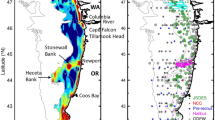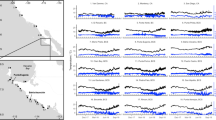Abstract
Seasonal development of dissolved-oxygen deficits (hypoxia) represents an acute system-level perturbation to ecological dynamics and fishery sustainability in coastal ecosystems around the globe1,2,3. Whereas anthropogenic nutrient loading has increased the frequency and severity of hypoxia in estuaries and semi-enclosed seas3,4, the occurrence of hypoxia in open-coast upwelling systems reflects ocean conditions that control the delivery of oxygen-poor and nutrient-rich deep water onto continental shelves1. Upwelling systems support a large proportion of the world's fisheries5, therefore understanding the links between changes in ocean climate, upwelling-driven hypoxia and ecological perturbations is critical. Here we report on the unprecedented development of severe inner-shelf (<70 m) hypoxia and resultant mass die-offs of fish and invertebrates within the California Current System. In 2002, cross-shelf transects revealed the development of abnormally low dissolved-oxygen levels as a response to anomalously strong flow of subarctic water into the California Current System. Our findings highlight the sensitivity of inner-shelf ecosystems to variation in ocean conditions, and the potential impacts of climate change on marine communities.
This is a preview of subscription content, access via your institution
Access options
Subscribe to this journal
Receive 51 print issues and online access
$199.00 per year
only $3.90 per issue
Buy this article
- Purchase on Springer Link
- Instant access to full article PDF
Prices may be subject to local taxes which are calculated during checkout




Similar content being viewed by others
References
Naqvi, S. W. A. et al. Increased marine production of N2O due to intensifying anoxia on the Indian continental shelf. Nature 408, 346–349 (2000)
Diaz, R. J. Overview of hypoxia around the world. J. Environ. Qual. 30, 275–281 (2001)
Rabalais, N. N. & Turner, R. E. in Coastal Hypoxia: Consequences for Living Resources and Ecosystems (eds Rabalais, N. N. & Turner, R. E.) 1–36 (American Geophysical Union, Washington DC, 2001)
National Research Council. Coastal Waters: Understanding and Reducing the Effects of Nutrient Pollution (National Academy Press, Washington DC, 2000)
Pauly, D. & Christensen, V. Primary production required to sustain global fisheries. Nature 374, 255–257 (1995)
Chavez, F. P., Ryan, J., Lluch-Cota, S. E. & Niquen, M. From anchovies to sardines and back: Multidecadal change in the Pacific Ocean. Science 299, 217–221 (2003)
Bakun, A. Global climate change and intensification of coastal ocean upwelling. Science 247, 198–201 (1990)
Roemmich, D. & McGowan, J. Climatic warming and the decline of zooplankton in the California Current. Science 267, 1324–1326 (1995)
Wheeler, P. A., Huyer, A. & Fleischbein, J. Cold halocline, increased nutrients and higher productivity off Oregon in 2002. Geophys. Res. Lett. [online] 30, 8021 (2003) (doi:10.1029/2003GL017395)
Freeland, H. J., Gatien, G., Huyer, A. & Smith, R. L. Cold halocline in the northern California current: an invasion of subarctic water. Geophys. Res. Lett. [online] 30, 1141 (2003) (doi:10.1029/2002GL016663)
Diaz, R. J. & Rosenberg, R. Marine benthic hypoxia: a review of its ecological effects and the behavioural responses of benthic macrofauna. Oceanogr. Mar. Biol. Ann. Rev. 33, 245–303 (1995)
National Marine Fisheries Service. Our Living Oceans (NOAA Technical Memo NMFS-F/SPO-41, US Department of Commerce, Washington DC, 1999)
Dillman, T. Abundance of Fish on Area Reefs Delights, Puzzles Divers (Newport News-Times, Newport, Oregon, 2002)
Huyer, A. Coastal upwelling in the California current system. Prog. Oceanogr. 112, 259–284 (1983)
Kamykowski, D. & Zentara, S. J. Hypoxia in the world ocean as recorded in the historical data set. Deep-Sea Res. 37, 1861–1874 (1990)
Fleischbein, J. Northeast Pacific long term observation program. US GLOBEC 〈http://globec.oce.orst.edu/groups/nep/index.html〉 (2003)
Huyer, A., Smith, R. L. & Pillsbury, R. D. Observations in a coastal upwelling region during a period of variable winds (Oregon coast, July 1972). Tethys 6, 391–404 (1974)
Oke, P. R. et al. A modelling study of the three-dimensional continental shelf circulation off Oregon. Part I: Model-data comparisons. J. Phys. Oceanogr. 32, 1360–1382 (2002)
Thomas, A. C., Strub, T., Brickley, P. & James, C. Anomalous satellite-measured chlorophyll concentrations in the northern California Current in 2001–2002. Geophys. Res. Lett. [online] 30, 8022 (2003) (doi:10.1029/2003GL017409)
Bailey, G. W., Beyers, C. J. B. & Lipschitz, S. R. Seasonal variation of oxygen deficiency in waters off southern south west Africa in 1975 and 1976 and its relation to the catchability and distribution of the cape rock lobster Jasus lalandii. S. Afr. J. Mar. Sci. 3, 197–214 (1985)
Morales, C. E., Hormazabal, S. E. & Blanco, J. L. Interannual variability in the mesoscale distribution of the depth of the upper boundary of the oxygen minimum layer off northern Chile (18–24S): Implications for the pelagic system and biogeochemical cycling. J. Mar. Res. 57, 909–932 (1999)
Strub, P. T. & James, C. Altimeter estimates of anomalous transports into the northern California Current during 2000–2002. Geophys. Res. Lett. [online] 30, 8025 (2003) (doi:10.1029/2003GL017513)
Barth, J. A. Anomalous southward advection during 2002 in the northern California Current: evidence from Lagrangian surface drifters. Geophys. Res. Lett. [online] 30, 8024 (2003) (doi:10.1029/2003GL017511)
Kosro, P. M. Enhanced southward flow over the Oregon shelf in 2002: a conduit for subarctic water. Geophys. Res. Lett. [online] 30, 8023 (2003) (doi:10.1029/2003GL017436)
Murphree, T., Bograd, S. J., Schwing, F. B. & Ford, B. Large-scale atmosphere–ocean anomalies in the northeast Pacific during 2002. Geophys. Res. Lett. [online] 30, 8026 (2003) (doi:10.1029/2003GL017303)
Fox, D. S., Amend, M., Merems, A. & Appy, M. Near-shore rocky reef assessment. Oregon Dept. Fish Wildl. Mar. Prog. 〈http://hmsc.oregonstate.edu/odfw/habitat/reports/2000kelp_reef_report.pdf〉 (2000)
O'Malley, R. SeaSoar observations during the Coastal Ocean Advances in Shelf Transport (COAST) mesoscale surveys I and II. 〈http://damp.coas.oregonstate.edu/coast/seasoar〉 (2003).
Acknowledgements
We thank A. Kirincich for ADCP analyses, S. Oda and A. Walters for assistance and A. Pazar for crab fishery data. The Partnership for Interdisciplinary Studies of Coastal Oceans, funded by the David and Lucile Packard Foundation, and the US GLOBEC program, jointly funded by NSF and NOAA, both contributed to this work. J.A.B. acknowledges additional funding from NSF. ODFW ROV survey work was funded in part by the Oregon Department of Land Conservation and Development through NOAA.
Author information
Authors and Affiliations
Corresponding author
Ethics declarations
Competing interests
The authors declare that they have no competing financial interests.
Supplementary information
Supplementary Table S1
Average, minimum and maximum DO and chl-a concentrations along the SH hydroline. (DOC 24 kb)
Supplementary Figure S1
Dissolved oxygen source properties and depletion patterns across the shelf. (DOC 1209 kb)
Supplementary Figure S2
Composite cross-shelf profiles of temperature, salinity, density, nitrate+nitrite, chlorophyll-a, and dissolved oxygen, SH line, 11-12 August, 2002. (DOC 78 kb)
Supplementary Figure S3
Chl-a concentration (mg l-1) at 5 meters depth over Heceta Bank from 9-11 August 2002. (DOC 214 kb)
Rights and permissions
About this article
Cite this article
Grantham, B., Chan, F., Nielsen, K. et al. Upwelling-driven nearshore hypoxia signals ecosystem and oceanographic changes in the northeast Pacific. Nature 429, 749–754 (2004). https://doi.org/10.1038/nature02605
Received:
Accepted:
Issue Date:
DOI: https://doi.org/10.1038/nature02605
This article is cited by
-
Widespread and increasing near-bottom hypoxia in the coastal ocean off the United States Pacific Northwest
Scientific Reports (2024)
-
Combined effects of hypoxia and starvation on the survival and growth rates of autotrophic, mixotrophic, and heterotrophic dinoflagellates
Marine Biology (2024)
-
A coastal Ramsar site on transition to hypoxia and tracking pollution sources: a case study of south-west coast of India
Environmental Monitoring and Assessment (2023)
-
Historical mass strandings of jumbo squid (Dosidicus gigas) in the Eastern Pacific Ocean: patterns and possible causes
Marine Biology (2023)
-
Transitions in nitrogen and organic matter form and concentration correspond to bacterial population dynamics in a hypoxic urban estuary
Biogeochemistry (2023)
Comments
By submitting a comment you agree to abide by our Terms and Community Guidelines. If you find something abusive or that does not comply with our terms or guidelines please flag it as inappropriate.



